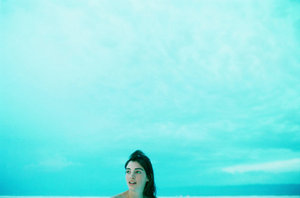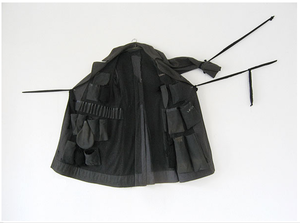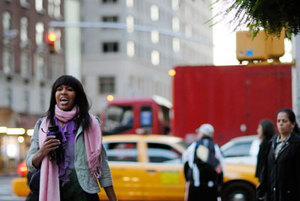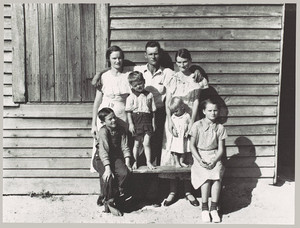This is an archive of the ArtCat Zine, 2007-2009. Please visit our new project, IDIOM.
April 2008
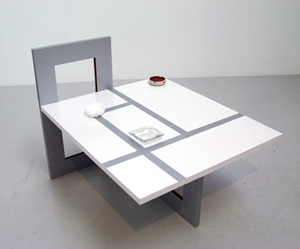
Seminars with Artists: Alice Könitz
7pm Thursday 1 May 2008
Whitney Museum of American Art - 945 Madison Ave New York, NY
$8
Alice Könitz's cross-media work often salvages the detritus of 20th century Euroamerican forms and turns them into both content and strategy. The artist is well known for her work with collage, video, and sculpture, the last of which has for the past few years taken the form as working or prototype furniture or architectural models often vacillating between utopian high-modernism and a kind of more postmodern irreverence for her such formal interests. For the Whitney Biennial, Könitz has taken steps into another very late 20th century institutional relational form: the artist offers Whitney patrons a chance to purchase a raffle ticket and potentially win a flight to Los Angeles for a three day stay near an unfinished strip of highway the artist describes as a personal source of inspiration. Tomorrow night at the Whitney, Könitz will present a talk as part of the museum's Seminars with Artists program.
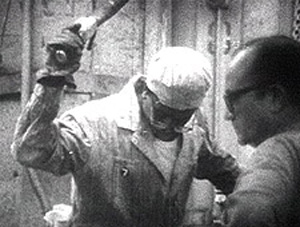
Finally Got the News
1968 Revisited: Film Screening and Discussion
7:30pm 1 May 2008
Brecht Forum - 451 West Street New York, NY
Sliding scale: $6/$10/$15
50 Artists, 50 Shots: We are All Sean Bell
7pm 3 May 2008
Brecht Forum - 451 West Street New York, NY
Free, but RSVP requested
It was with a deep sense of regret that many of us here in New York read this weekend of the acquittal of all three NYPD officers charged in the 2006 shooting of 23 year old Sean Bell, an unarmed African American who died in Jamaica, Queens at the time of his bachelor party in a hail of 50 police bullets. Brecht Forum has organized an exhibition and evening of performance in response to the outcome, inviting 50 as of yet unnamed artists to present work in 50 Artists,50 Shots: We are All Sean Bell. The exhibition and performance takes place this Saturday at the Forum. The press release reads:
This is an outcry responding to the verdict of Sean Bell's case. Artists, Community Leaders and Activists come together to educate, share, learn, mourn, and inspire all of us on the Sean Bell case, the legal system, transformation, and action. This will be a Free Event and All Performances are Voluntary. First come basis, once we have all 50 Artists the list will end.
Also at Brecht Forum this week on the occasion of International Worker's Day, the 1970 documentary film Finally Got the News will be presented along with an accompanying discussion scheduled to follow. Finally Got the News chronicles the late 60s struggles of The League of Revolutionary Black Workers in and outside the automobile factories of Detroit, Michigan, framing the movement in the complex racial and class specificities of the struggle for social justice in America. The film could well serve to prompt New Yorkers to broader thinking about the often times Francocentric historicizing of '68 as an allegedly worldwide rupture in the social fabric firmly centered and emanating from Paris out to remainder of the world.
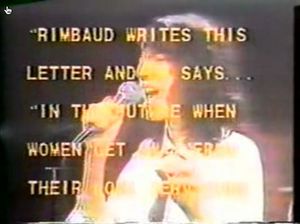
Rock My Religion
7pm Thursday 1 May 2008
ISSUE Project Room - 232 3rd St, Brooklyn NY
$10
This Thursday, ISSUE Project Room in downtown Brooklyn will present a screening of Dan Graham's 1984 video essay Rock My Religion. The work is a mélange of American historical narratives from 17th century religious sepratism of the transplanted Christian diaspora and the parallel and rapidly developing industrialized workforce, to the 20th century populist vanguardism of rock and roll music and its supporting cultural apparatus. The video was recently screened in town as part of the Orchard Gallery Presents program of the New York Underground Film Festival, the not-for-profit's swan song film program on the occasion of the cooperative exhibition site's final year on the Lower East Side. While it would be nothing if not imprudent to read these two recent exhibitions of the work as some sort of marker of renewed interest in Graham's video and its formal and thematic concerns, it remains interesting to imagine the possibilities of the desire for such a revisiting. In what is certainly to be a few more months of intense historical surveying forty years since '68, the video might suggest an alternative, if incomplete, answer to the generally modernist project against economic inequity. Religious fundamentalism, after all — as Dan Graham implicitly posits in the work, and as contemporary cultural theorists like Boris Groys have more explicitly suggested — is just another oppositional response to the global regime of neoliberal capitalism, and at that a particularly resistant one. Forty years in the wake of the simultaneous strategic, cultural, and social revolt against such a regime across Europe, whose stranglehold on daily life the world over has nothing if not strengthened with time, signals, perhaps, an incentive to revisit pre-Enlightenment strategies of resistance — strategies as potentially terrifying as the unbearable conditions they seek to allay.
Brooklyn Street Art Auction
7-10pm Friday 25 April 2008 (last bids at 9:30 pm)
Ad Hoc Art - 49 Bogart St., Brooklyn NY
Tonight at 7:30, at Ad-Hoc Art's Williamsburg exhibition space, Free Arts NYC will be hosting a silent auction to benefit the publication of Jame Rojo's new book of photography, Brooklyn Street Art. Twenty five works by emerging and a few established street artists will be on the auction block, including multiples by Swoon and WK Interact.
More information and images on Brooklyn Street Art's website.
Q's and A's: Molly Nesbit with Elmgreen & Dragset
6pm Thursday 24 April 2008
Office of Contemporary Art Norway - 25 Broadway New York NY
Amy Sillman on John Chamberlain
6:30 Monday 28 April 2008
Dia Art Foundation - 535 West 22nd Street New York, NY
$6
This Monday, 28 April, painter Amy Sillman will give a public talk on the art of American sculptor John Chamberlain, whose work is currently on view at Dia Beacon. The program is part of Dia Foundation's Artists on Artist series where artists are invited to speak about the work of older colleagues.
Tonight downtown at the Office for Contemporary Art Norway meanwhile, writer and art historian Molly Nesbit will present a talk with Elmgreen and Dragset, the Berlin-based collective effort of artists Michael Elmgreen and Ingar Dragset who have presented work internationally since 1995 and most significantly at last year's Skulptur Projekte Münster.
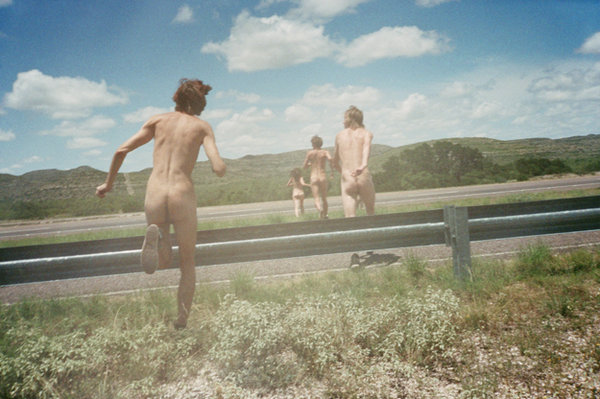
Ryan McGinley
I Know Where the Summer Goes
Ryan McGinley
3 April - 3 May 2008
Team Gallery - 83 Grand Street, New York NY
New York based photographer Ryan McGinley made a surprising admission in the press release for his latest show, I Know Where the Summer Goes: his photographs are staged. In fact, the lithe young things writhing in the 30 or so pictures on display at Team Gallery are models that he cast in an official casting call where each potential model was judged on "mellowness... strong personalities," comfort naked and "long-limbed[ness]." And then the road-trip across the country was meticulously planned, with locations extensively researched for their symbolic weight and McGinley planning plenty of activities for his hired cadre of enthusiastic companions to partake in. The truth is that McGinley’s images have always been staged in his drive to create an aesthetic world where youth runs wild against the backdrop of iconic landscapes of the American West, this is just the first time he admitted it on paper.
This explicit admission forces the photographs to stand on their own, without playing on the audience’s fantasies about the spontaneity of their creation. In previous bodies of work, McGinley’s photographs have largely ridden on their off-the-cuff sex appeal: the images have captivated viewers with their patina of sex, drugs and rock n’ roll, without any of the harsh, gritty, uncomfortable realism of documentary photographers Larry Clark or Nan Goldin. In the former photographic world of Ryan McGinley, youthful exuberance trumped all as adolescents playfully wrestled, jumped, frolicked, fed horses, and unselfconsciously fucked in shower stalls.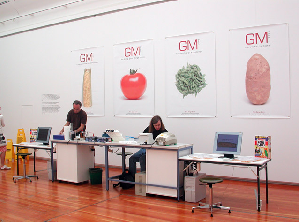
This past Monday, 21 April, Federal Judge Richard J. Arcara ruled to dismiss the indictment against University of Buffalo Professor and Bio-Artist Steven Kurtz, a member of the Critical Art Ensemble. The ruling comes as a happy suspension of the legal persecution Dr. Kurtz has been suffering since his 2004 arrest and subsequent targeting by the Joint Terrorism Task Force, first on suspicions of "bioterrorism" charges, and later reduced to mail fraud and wire fraud charges for the acquisition and transport of certain legally available biological lab equipment and some few hundred dollars worth of harmless bacteria culture. At the time Kurtz was developing an installation called Free Range Grains, which allowed participants to test food for the presence of genetically modified organisms. While the prosecution may yet appeal the judge's decision, and consequently take the case up to a higher federal court, Judge Arcara's ruling was welcome by Dr. Kurtz and his legal counsel and may yet be a signpost for a just resolution to a terrific mobilization of law enforcement against a symbolic and precedent-setting target. To learn more about Kurtz's work or his legal battles, please visit Critical Art Ensemble Defense Fund.
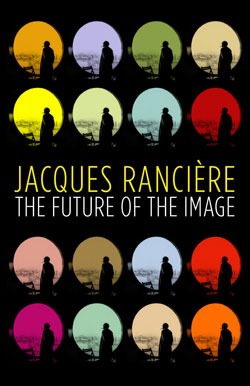
The Future of the Image
Jacques Rancière and W.J.T. Mitchell,
6:15pm Wednesday 23 April 2008
Columbia University: Schapiro Center - 2960 Broadway New York, NY
With the waning dominance of Jacques Derrida and French post-structuralist thought in recent years, a younger generation of French intellectuals have been able to move into the international centers of attention and attract wide, cross-disciplinary readership. Few have been as successful as Jacques Rancière, a one time Young Althusserian, whose densely layered and ambitious writings on politics and aesthetics have been translated into several languages and distributed internationally. In his more recent short books like The Politics of Aesthetics and The Future of the Image, Rancière seeks a way of returning the question of the political to the realm of the aesthetic while emphasizing the lack of center in advanced visual practice as a liberatory model for a politics to come. Rancière's popularity in that vaporous system signified by the mainstream "art world" was perhaps calcified most clearly in last year's March issue of Artforum in which the journal re-published a revised edition of one of the philosopher's English language lectures (previously published by the Continuous Project collective), an interview between Rancière and artists Fulvia Carnevale and John Kelsey, and accompanying short texts by Kristin Ross, Bettina Funcke, Paul Chan, Liam Gillick, and Thomas Hirschhorn.
This Wednesday evening Columbia University will present a public talk between Jacques Rancière and critic and philosopher W.J.T. Mitchell on The Future of the Image. There is no RSVP service or reserved seating for this event, so early attendance is suggested.
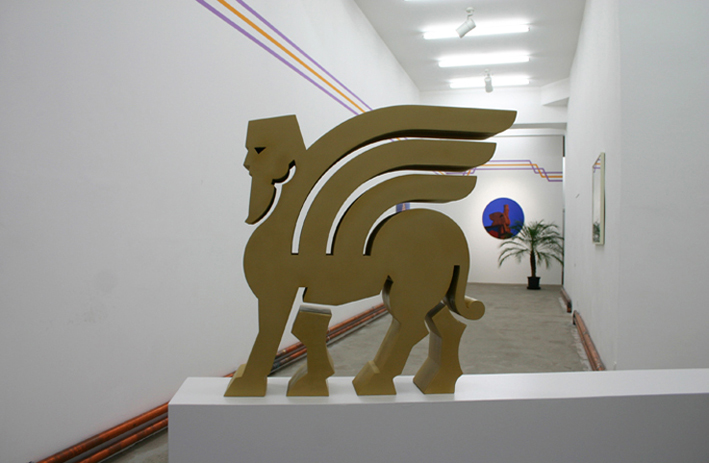
City of Commerce
Sophie-Therese Trenka-Dalton’s
Nice & Fit - Brunnenstrasse 13, Berlin DE
3 April - 24 May 2008
Heiligsprechung
Jana Gunstheimer’s
filiale - Brunnenstrasse 188-190, Berlin DE
4 April - 24 May 2008
Running concurrently, directly across the street from each other in Berlin, are exhibitions by Sophie-Therese Trenka-Dalton and Jana Gunstheimer.
Gunstheimer’s Heiligsprechung (Canonization) covers a period of time starting in 1977 when citizens in Austria could apply for sainthood. The exhibition is filled with the documents and artifacts of the applicants, and the eventual exposure of the government’s offer as a sham designed to generate revenues from application fees.
Trenka-Dalton likewise digs into history for her exhibition City of Commerce, which examines Assyrian culture in a manner that is now almost the only way left to experience it: through its material representations and reconstructions in museums, reproductions on postcards, or its influence on contemporary architecture. Some of her artifacts are gathered from actual field trips: not to Iraq, but rather to sites like the Louvre, the British Museum, and The Citadel, an outlet mall in a suburb of Los Angeles housed in what used to be a tire factory modeled on the Palace of King Sargon II.
The exhibitions have much in common. Both women are excellent crafts-persons and both have chosen the language of museums — the vaults of history — to speak on the unreliability of these stories.
In the case of Heiligsprechung, the feeling of the exhibition is similar to having entered a shrine dedicated to a singular event. The model of the arch, that was to be constructed over the street where the saints would be paraded, feels cheap. It is wonderfully constructed, but from materials that betray the museum’s limited budget. The framed application forms of the people eager to be recognized for their goodness are yellowed with time, and it is easy to imagine an elderly volunteer sitting in a tobacco-stained ticket booth at the entrance to these collected stories. And what stories they are! Take for example a group of criminals determined to reform themselves for the good; as a symbol of their intentions, the group had their wrists tattooed declaring their resolve: to be kind, to protect you, to shield your life from the sort of persons they used to be. But how sincere are they? The cover letter they turn in with their sainthood application form is rather dodgy, and we begin to suspect that these men are not as reformed as they'd like us to believe.
Introduction to Collecting Photography Books
6:30 Tuesday 22 April 2008
Aperture Gallery - 547 W. 27 St, New York NY
Aperture foundation hosts Introduction to Collecting Photography Books a panel discussion this Tuesday at Aperture Gallery in Chelsea. The panel will include publisher Lesley Martin of Aperture Foundation, Harper Levine of Harper's Books, Daile Kaplan of Swann Galleries, and more. The panel will be moderated by i heart photograph's Laurel Ptak.
Blackboxing
Mariana Castillo Deball
5-8pm Wednesday 16 April 2008
3-6pm Friday 18 April 2008
30 min.
Artists Space - 38 Greene St, 3 Fl., New York NY
The industrialized world is increasingly constituted by a complex network of equipment, in the Heideggerean sense — and then again in a translated sense, or das Zeug. As new technologies are developed, or existing technologies move into new spheres of social space, one of the consequences is that such things also move towards transparency. The utopian ambition of early art video makers, for instance, resulted in motion pictures with a very conscious attitude to the emerging technologies those producers were using. Today, perhaps the video camera has gone the way of the hammer, to use one of Heidegger's favorite examples, the ultimate ready-to-hand — that is, we only notice it when its breaks. It is a similar spirit of simultaneous technological sophistication, social integration, and vanishing in which Mariana Castillo Deball presents her 2007 video Blackboxing at Artists Space tonight and then again on Friday. The eponymous concept "refers to the way scientific and technical work is made invisible by its own success." The popularity of the Apple computer company, to seize on one example that comes immediately to mind, is founded not on that company's refinement of the personal computer as an object but rather its erasure: the material scaling down of the computer into slimmer and over-designed models conceived to integrate elegantly with the furniture of the home or office, to become another piece of equipment. Castillo Deball's press release for the event continues:
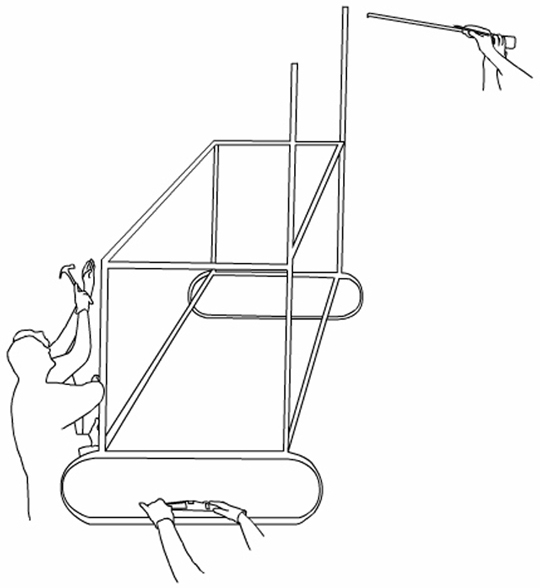
When a machine runs efficiently, when a matter of fact is settled, one need focus only on its inputs and outputs, not on its internal complexity. As a result, the more science and technology succeed, the more obscure they become. "Blackboxing" is the process that makes the joint production of actors and artifacts entirely opaque. Castillo Deball is interested in devices, individuals, and events that evade this effect: unfinished stories, ambiguous characters, incomplete objects and so on. These elements typically belong to a process from which they were excluded, or their interests and links belong to different categories, making it impossible to fix them in a specific place. In her work, these fragmented pieces of imaginary machinery lead to chain reactions, as if each part might be trying to find a connection, a tiny place to settle for a while.
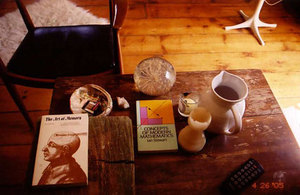
Open Studios: Carol Bove
2pm Friday 18 April 2008
Whitney Museum of American Art - 945 Madison Ave New York, NY
$museum admission (15)
This Friday the Whitney invites Carol Bove to speak as part of Open Studios, a series of afternoon artist's talks. Bove's work has for years been immersed on the forms and narratives of 60s American cultural life, both high brow and low. The resulting a body of work perhaps will come under increased scrutiny in the light of this year's intensive historical and popular interest, commemoration, and narratization (not to mention last year's liquidation, the designs of which were fiercely advocated by at least one purported neo-Gaullist) of the mostly Eurocentric legacy of May '68, the fortieth anniversary of which is marked this year. Whether described as a strategic, socialist union of an intellectual minority and popular worker and student movements, or a cynically libertarian (and libidinal) "merry month" -- the legacy of '68 will be hotly contested for many years to come. Bove's work may in fact offer some very contemporary sensibilities in the realm of sculpture and image making to the trace materials and historical documents of this important 20th century moment.

Vection, the perception or sensation of motion, decreases with prolonged exposure to movement. Thus after even a short period of travel at high speeds, the body loses its ability to recognize that it is moving at all. In these cases even the appearance of something stationary recovers only the understanding of motion, not the feeling.
It would seem, then, that, for a while now, the Whitney Biennial has served as just such a stationary object. Set to one side of the artistic superhighway, it is relegated the dubious task of reminding us of what we understand but no longer feel; that we are moving very fast indeed. Let those traveling on different roads marvel and squint at what a strange and wonderful playground art has built for itself. Let those not strapped to the hurtling hyperdrive of an industrialized cynicism exclaim: My fellow Americans, the state of the union is strong! It is not for us, we priestly guardians of the tender and delicate critical flame to risk its light by noting, even in passing, how far we may have come. It is not news.
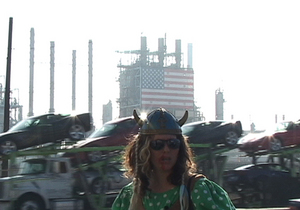
Take the decision to put the Biennial in the hands of two young curators, each well under forty. Well, it's not really theirs, you know? They had help, were overseen, and in any case are firmly entrenched in the institution. Take their subsequent decision to give certain artists their own space to fill as they wished, rather than merely assembling a collection of prefabricated works. Well we've seen that sort of thing before, it shouldn't be understood as any sort of generosity on their or the museum's part, and in any case it fails more often than it succeeds. Take the extension of the show into realms of performance, installation, and general madness at the Park Avenue Armory. Well we can drink Tequila at home, no need to go to a museum for that. Take the almost total absence of painting, still the most widely disseminated shorthand for art in the larger context: would've been more interesting if they'd left it out entirely, Jerry Saltz assures us with a sigh, then at least everyone would have gotten hysterical.
Is that what it takes, Jerry? A giant sign screaming 'No More Painting Ahead'?
The point here is less to demonstrate extensive, structural cynicism, and still less to castigate those who might be most representative of it – Saltz is rarely the problem in this regard. Instead, we might ask, with an artistic practice so omnivorous, so totally coextensive, where might we stand in order to approach something like the 2008 Whitney Biennial with something like an appropriate critical facility. I have tried to sketch what the loss of this standing room implies for our ability to appreciate experimentation and creativity in an institutionalized context, but one could just as easily take the opposite track and demonstrate a similar inability to articulate precisely what is wrong with such gestures. Such a critique would require abstaining radically from the well-worn tropes of Biennial fatigue so as to indicate clearly the social and material stakes in play.
The Feminist Future Series: Gender and Film
5:30 Friday 11 April 2008
MoMA, Titus Theater 2 - 11 W 53 St, New York NY
$10
1717 Troutman Benefit and Silent Auction
6-9pm Sunday 6 April 2008
Exit Art - 475 10th Ave, New York NY
$20 suggested
Tonight MoMA hosts Gender and Film, part of the Feminist Future Series, an ongoing extension of the panel discussions and symposia that institution hosted last year in January. Last year's events featured 2 days worth of back to back panels and performances with an impressive and international cast of artists, curators, and writers surveying of the landscape of contemporary feminist discourse in art, and maybe life, too, and hypothesizing a possible future(s) to such a discourse. Filmmakers Trinh Minh-ha, Chantal Akerman, and critic Laura Murvey will join tonight to "discuss their own practices, the historicization of feminism and film, and the cultural and social contexts that inform the creative process of filmmaking."
On Sunday, the 1717 Troutman Tenants' Association, an organization formed in response to the extremely disruptive moves by city officials to evict several artists using spaces in the Ridgewood building, is having a silent art auction and benefit to raise funds for their efforts. The suggested $20 donation will buy entry and free drinks throughout the night. All of the funds raised will go directly to support the vacated artist tenants of 1717 Troutman.
Lady Pink and Aiko: Brick Ladies of NYC
Ad Hoc Art - 49 Bogart Street, Brooklyn NY
21 March - 20 April 2008
The work of Lady Pink will be on view at the Ad-Hoc Art Center in Brooklyn until April 21st. This legend of New York's graffiti scene shares the show with a younger counterpart, Aiko, who is also a rising star.
Lady Pink came of age in the old New York of the 1970s and 1980s. She made her name as the first major woman graffiti artist who held her own against the male competition when it came to gracing (or vandalizing) the trains with new designs. The city's graffiti gang would siege the MTA train yards at night, evade transit police, and write on the trains. Today's shiny silver metal subway cars were actually specifically designed to accommodate a chemical solution that can swiftly rinse off any graffiti. The old trains received a coat of red paint and were therefore a far better canvas for spray paint.
Much of the general public view spray painted trains as vandalized signs of urban decay. Those with eye for Graffiti experienced sublime suspense as the headlight shined in the distance. It would always be a surprise to see "whose" subway would pull into the station. Would it be a design that had been plowing through the tunnels for a couple of weeks? Would it be new work that was just done last night? This was the golden age of New York Graffiti.
Musical
Dara Friedman
6:30pm Wednesday 9 April 2008
The New School - Tishman Auditorium, 66 West 12th Street New York, NY
Dara Friedman presents Musical this evening at the New School, a new 49-minute video work commissioned by the Public Art fund last fall. The work features some 60 singing performances in public sites around midtown Manhattan, by various individuals, synthesized by Friedman in the editing room to allow "the singers to harmonize with themselves, sing unintentional duets, or even create dissonance." Friedman's work here, like that of the artist Sharon Hayes reading love letters to unsolicited crowds last fall in the heart of midtown, produces images of solitary, discordant figures set against the otherwise normalized landscape of everyday white collar labor practice. Something about midtown Manhattan meanwhile manages to absorb all but the greatest disruptions: a performance artist, an eccentric vagrant, a voice in song, or an experimental filmmaker — all become implicit in the terrain of structured heterogeneity of concrete, glass, office workers and service workers. A former student of Austrian experimental filmmaker Peter Kubelka, Friedman's work is deeply indebted to an austere structuralist insistence on form in filmmaking, sometimes resulting in images that are significant primarily via their very presence and relation to other images, rather than their content. Friedman's work, on the other hand, has frequently been populated by bodies engaged in motion and discoursing with others, their presence mediated, meanwhile, by Friedman's often fierce and methodical editing.
Archive Fever - Uses of the Document in Contemporary Art
8 January 2008 - 4 May 2008
International Center for Photography Museum - 1133 Avenue of the Americas New York, NY
Archives are a ubiquitous institution, but the significance of an archive threatened by war is an entirely different animal — in its new and tenuous position, it changes drastically in terms of size and form. Archive Fever – Uses of the Document in Contemporary Art, at the International Center of Photography, explores and exposes as many aspects, structures, and uses of archiving as can be explored and exposed, and at the same time seems to have reserved, wisely, a little extra space for photographs, videos, and projects born of/predicated on human strife. It is an incredibly unfrivolous show.
Although an exhibit that particularly wants to translate historical events from the 1960s to the present is bound to become caught up in the sadder episodes of those years, the curator, Okwui Enwezor, folds them into Archive Fever so that, more than anything else, they make sense. Where a series of photographs of terrorists’ relatives’ hands could have awkwardly glared at its viewers, the pictures’ purpose is well-exercised within the form of the show. Looking around, and equally importantly, reading the accompanying text to each exhibit, bestows a very present feeling that this show has been quite actively assembled.
What Enwezor has created is a web of references to and reenactments of revolutions, civil wars, segregation and deprivation. These solemn pieces are spread among works like Christian Boltanski’s stacked, dimly lit boxes labeled with black and white photos (evoking a conventional view of an archive) and Glenn Ligon’s room full of Robert Mapplethorpe’s black and white pictures of nude black men (re-archiving another archive, and bringing to light myriad questions regarding the validity and nature of the photographs themselves.) Ligon’s piece is spangled with commentary from myriad sources, and through this conceit becomes archetypical of the show – it depicts archiving for the sake of archiving. More importantly, however, from its heightened awareness of what it means for an archive to fill the roll it does, Notes on the Margin of the Black Book, like Archive Fever as a whole, appears intelligently in earnest about the significance of its own subject matter.
After a week of intensive art fair coverage on our parallel fair blog, we're pleased to post Brent Burket's scattershot impressions of The Armory Show. An excerpt follows:
I always pay attention when I'm unusually hungry for a certain piece of music. It always reveals a little bit about where my head and heart are residing in a given moment. Crossing 9th Avenue on my way to the Armory I was overcome by the desire to listen to the biggest and dumbest song I could find on my iPod, Fish's live version of The Heart of Lothian. Turned out that having the barrel-chested Scotsman in my ears was a perfect way to prepare for the annual goofy-ass grandness of the Armory. Onward!
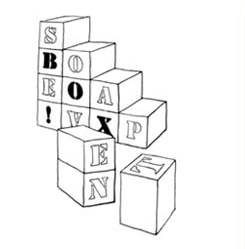
New York Underground Film Festival
Various times
Wednesday 2 April - Tuesday 8 April 2008
Anthology Film Archives - 32 Second Ave, New York NY
Soapbox Event
2-5pm Saturday 5 April
Federal Hall National Memorial
This week marked the start of the 15th and final New York Underground Film Festival, which is restructuring this year into something other than its current, well loved and attended, annual festival form. Recommended this weeked in particular is The Only Possible City, a three part screening series organized by Mike Crane, Ryan Garrett and Edward Kihn, featuring theorist Manual De Landa's late 70s opus Raw Nerves: A Lacanian Thriller, Matthew Buckingham's rumination on an aborted proto-cinema history in False Future, and Harun Farocki's study of cinematographic representations of incarcerated bodies in Prison Images. Also recommended strongly is Orchard Gallery Presents, a double-bill screening organized by the eponymous downtown gallery that is also currently in its last year as an exhibition space. The program will screen Rock My Religion, Dan Graham's culture studies amalgam of Punk Rock and the Christian Diaspora, and Alain Resnais's Toute la Mémoire du Monde. Jim Finn will present The Juche Idea, a highly-stylized fictional portrait of a South Korean video artist inspired, while on a residency in North Korea, to adapt the "serious, thorough and sharp" critical language of revolutionary art to her own practice. The Phantom Menace will feature several short videos by James Fotopoulos and Mark Ther, among others. Where's the Love? is another program of shorts featuring recent video works by Michael Robinson, Drew Heitzler, and Peggy Ahwesh. Also strongly recommended is NYUFF's second TubeTime!, a kind of game show in which competitors trade found Internet media on the big screen to audience reactions.
On Saturday from 2-5pm at the Federal Hall National Memorial, artist Pia Lindman will present Soapbox Event, a public work in which people are invited to stand on provided soapbox structures and express themselves publicly for one minute — the boxes metaphorically ensuring freedom of expression (perhaps also implying that the speaker of unpopular opinions will now need an emphasized freedom to enunciate) and an assembled body of participant-spectators to receive the message. With these bare ground rules in place, participants are free to form coalitions with others and stack soapboxes to expand the time for free speech and produce longer orations.
Architecture & Illumination
6:30-8pm Thursday 3 April 2008
Museum of Arts & Design: 40 West 53rd Street
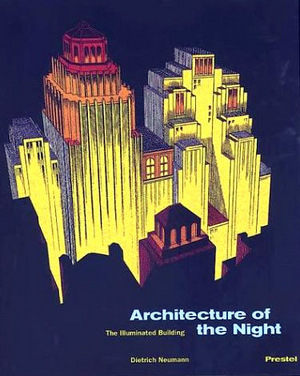
New York, in some ways, is the same city at night as it is in the day. Its most iconic material features — its buildings and monuments — are of course lit at night and made, perhaps, even more visible in the partial darkness that hasn't been able to swallow the city whole, or even in part, since the late summer Northeast Blackout of 2003. The experiments with light and architecture have continued throughout the 20th century so now that even an absence may be illuminated: an architectural presence affirmed only with light is showcased most definitively by the Tribute in Light the two soaring vertical light beams installed in 2002 at the WTC site shortly after its destruction by terrorists that previous September.
Such incorporation of large-scale, powerful electric lighting with the city's architecture has been aggressively expanded since the 1930s, and even then was only the natural progression of earlier urban integration of gas lighting in the 19th century. Tonight at the Museum of Art & Design, historian of architecture Dietrich Neumann presents Architecture & Illumination, a talk on how "architectural lighting has completely transformed the way we perceive and navigate our cities" in the 20th century. From the press release:
Professor Dietrich Neumann will speak about the history of architectural illumination, and the use of electrical lighting a "new building material." Neumann will present the debates that accompanied this development and discuss historic and contemporary examples including the pivotal Chicago Tribune building, whose architect, Raymond Hood, coined the phrase "architecture of the night." "Architecture of the Night" was also the title and subject of an acclaimed international exhibition Neumann curated for the Kunstmuseum Stuttgart and the Netherlands Architecture Institute in Rotterdam, where it was shown until May 2007.
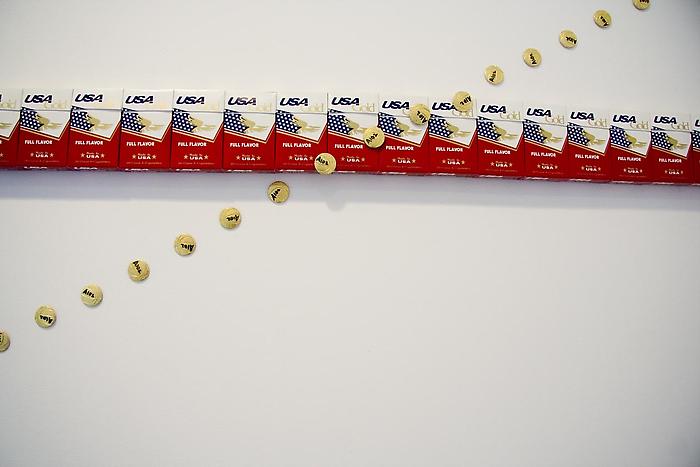
Winning is Not For Everyone
Mike Quinn
Perry Rubenstein Gallery - 534 W 24 St
27 March - 17 May 2008
Obsessions tend to be unhealthy. Though often personal and familiar to the soul, obsessions occupy so much space in one's mind that living with them becomes obvious, even manageable. Over the years, if an obsession does not wane, the best thing to do is focus your creative energy on it, milk its potential for inspiration and use it to your advantage. After all, it's clearly not going anywhere. I've learned to make mine into vital subjects that I can dissect, expound upon, rethink and recreate. If, however, life becomes a heavy burden, overwhelmed by obsessive tendencies in any direction, things can get increasingly complicated. No one is devoid of problems; scope and gravity may vary, but corrosive tendencies are never wholly unfamiliar. Mike Quinn's new solo exhibition at the Perry Rubenstein Gallery, Winning is Not for Everyone is a personal exploration of some of his more somber thoughts, their resolutions, and an obsessive love for basketball.
Fools!
8pm 1 April 2008
Light Industry - 55 33rd Street 3rd Fl., Brooklyn NY
$6
Tonight at Light Industry in Sunset Park, filmmakers Bradley Eros and Brian Frye preset Fools!, a program of short films and videos on the occasion of the the first of April. From the Press Release:
Ubi umbras, ibi fatuis [Where there are shadows, there will be fools.]
April 1st: This is the day upon which we are reminded of what we are on the other three-hundred and sixty-four. -Mark Twain
Calling all ye fools! April fools, holy fools, royal fools, crazy fools, fools tragic, innocent & lovelorn. Ye jokers, pranksters, and just plain idiots. On a day honoring the Scottish custom known as ³hunting the gowk," (i.e. the cuckoo) & other festivities of absurdity dating back to antiquity, the "original" Robert(a) Beck Memorial (Mercurial) Cinema - Brian Frye & Bradley Eros present, not an exaltation of larks, nor a murder of crows, but a ship of fools, daffy & loony, dim & running amok! Featuring FILMS new, tarnished & disinterred, all brought to light for the occasion by Elle Burchill, Jeanne Liotta, Marie Losier, Deadly Doris (Die Tödliche Doris), the Brothers Mekas & Kuchar, Tony Ganz & Rhody Streeter & Aphex Twin. PLUS, silent comics & moronic soundies, early porn & looney tunes.
ZINE
HOME
TIPS / COMMENTS
CATEGORIES
CONTRIBUTORS
- Greg Afinogenov
- B. Blagojevic
- Adda Birnir
- Susannah Edelbaum
- Julie Fishkin
- Paddy Johnson
- Jessica Loudis
- Christopher Reiger
- Andrew Robinson
- Peter J. Russo
- Blythe Sheldon
- S.C.Squibb
- Hrag Vartanian

